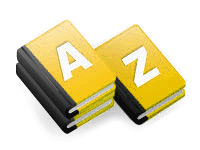What Are All These Terms?

Alternation Current (AC) - Current which varies from zero to a positive maximum to zero to a negative maximum to zero, a number of times per second, the number being expressed in cycles per second of Hertz (HZ).
Alternator - A device for converting mechanical energy into electrical energy.
Amperage - The strength or intensity of an electric current, measured in amperes (AMPS).
Battery Charge Rectifier - A component which changes AC voltage from the battery charge windings (within the STATOR) to DC voltage. This voltage could be used to charge a battery.
Brush - A conducting element, usually graphite and/or copper, which maintains sliding electrical contact between a stationary and a moving element.
Conductor - A wire or cable designed for the passage of electrical current.
Contactor - A contactor is an electrically operated switch usually used in control circuits and whose contacts are considered high amperage compared to a relay.
Core - The laminations in the generator constituting the magnetic structure thereof.
Cradle - The metal frame that surrounds and protects the generator/engine.
Current -The flow rate of electricity.
Cycle - One complete reversal of alternating current of voltage, from zero to a positive maximum to zero to a negative maximum back to zero. The number of cycles per second is the frequency, expressed in Hertz (HZ).
Diode - A solid-state device which allows current to pass in one direction only. Since it allows only one-half cycle of an alternating current pass, its output will be unidirectional and it may be considered a rectifying element.
Direct Current (DC) - An electric current flows in one direction only. DC is produced by chemical action (i.e. a storage battery) or by electromagnetic induction.
Dynamo - A machine for converting mechanical energy into electrical energy by electromagnetic induction - a generator.
Electro-Motive Force (EMF) - The force which causes current to flow in a conductor; in other words, the voltage potential.
Full Power Outlet - Enables you to draw the full power of the generator out of one outlet.
Generator - A general name for a device that converts mechanical energy into electrical energy. The electrical energy may be direct current (DC) or alternating current (AC).
Ground - A connection, intentional or accidental, between an electrical circuit and the earth or some conduction body serving in the place of the earth.
Idle Control - A system that controls the idle speed of the engine in direct relation to the electrical load.
Ignition Coil - A device used to supply DC voltage to the spark plugs.
Magneto- An alternator with permanent magnets used to generate current for ignition in an internal combustion engine.
Ohm- Unit of electrical resistance. One volt will cause a current of one flow through a resistance of one ohm.
Phase - The uniform periodic change in amplitude or magnitude of an alternating current. Three-phase alternating current consists of three different sine wave current consists of three different sine wave current flows, different in phase by 120 degrees from each other.
Power Transfer System - A system to safely wire your generator to your home's electrical system.
Rated Speed - Revolutions per minute at which the set is designed to operate.
Rated Voltage -- The rated voltage of an engine generator set is the voltage at which it is designed to operate.
Rear Bearing Carrier - The casting which houses the rotor bearing which supports the rotor shaft.
Rectify - A device that converts AC to DC.
Relay - An electrically operated switch usually used in control circuits and whose contacts are considered low amperage, compared to a contactor.
Resistance - Opposition to the flow of current
Rotor - The rotating element of a generator.
Single Phase - An AC load, or source of power normally having only two input terminals if a load or two output terminals if a source.
Stator - The stationary part of a generator.
Vibration Mount - A rubber device located between the engine or generator and the cradle to minimize vibration.
Volt - The unit of electromotive force. That electromotive force which when steadily applied to a conductor whose resistance is one ohm will produce a current of one ampere.
Voltage - Electrical potential difference expressed in volts.
Voltage Regulator - A component which automatically maintains proper generator voltage by controlling the amount of DC exitation to the rotor.
Watt - Unit of electrical power. In DC equals volts times amperes. In AC equals effective volts times effective amps times power factor times a consistent dependent on the number of phases. 1 kilowatt - 1,000 watts.
Winding -All the coils of a generator. Stator winding consists of a number of stator coils and their interconnections. Rotor windings consist of all windings and connections on the rotor poles.




